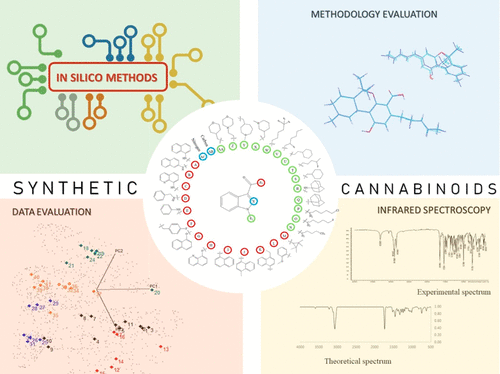当前位置:
X-MOL 学术
›
J. Chem. Inf. Model.
›
论文详情
Our official English website, www.x-mol.net, welcomes your
feedback! (Note: you will need to create a separate account there.)
In Silico Infrared Characterization of Synthetic Cannabinoids by Quantum Chemistry and Chemometrics.
Journal of Chemical Information and Modeling ( IF 5.6 ) Pub Date : 2020-03-02 , DOI: 10.1021/acs.jcim.9b00871 Jade Simões de Castro 1, 2 , Caio Henrique Pinke Rodrigues 1, 2 , Aline Thaís Bruni 1, 2
Journal of Chemical Information and Modeling ( IF 5.6 ) Pub Date : 2020-03-02 , DOI: 10.1021/acs.jcim.9b00871 Jade Simões de Castro 1, 2 , Caio Henrique Pinke Rodrigues 1, 2 , Aline Thaís Bruni 1, 2
Affiliation

|
The concept of forensic sciences as mere trace analysis has been modified by the idea of forensic intelligence, which entails applying data to make decisions within the investigative process. Many countries are engaged in combating drug trafficking and drug use because they are related to public health and safety issues. Prohibiting the consumption of traditional drugs has led new psychoactive substances (NPSs) to emerge. NPSs consist of compounds that resemble the initially banned substance and which aim to mimic the traditional drug recreational effects while circumventing drug legislation. For example, synthetic cannabinoids are sprayed on herbal products to reproduce the cannabis recreational effects. According to the United Nations Office on Drugs and Crime (UNODC), the toxic effects of synthetic cannabis types are unknown, and harm and fatalities associated with the use of these drugs have been reported. Information on the characterization related to these species is lacking. The rate at which NPSs appear poses a significant challenge because employing conventional methods to understand the characteristics of these compounds may require time and be costly. This work uses in silico practices as an alternative to understand how NPSs related to cannabis behave. We apply quantum chemistry methods to evaluate several synthetic cannabinoids recognized in forensic samples. More specifically, we generate infrared spectra that can be employed as a benchmark for NPSs. We apply a multivariate classification to evaluate the results. We conclude that in silico methods are an alternative that provide information about the spectra of undetected substances. This information can help to identify new drugs, to increase knowledge about them, and to feed information procedures.
中文翻译:

通过量子化学和化学计量学对合成大麻素进行计算机红外表征。
法医科学的概念,仅是痕量分析,已被法医情报的思想所修改,该思想要求将数据应用于调查过程中的决策。许多国家参与打击毒品贩运和毒品使用,因为它们与公共卫生和安全问题有关。禁止传统药物的消费导致了新型精神活性物质(NPS)的出现。NPS由类似于最初禁用物质的化合物组成,旨在模仿传统的药物消遣作用,同时规避药物立法。例如,将合成大麻素喷洒在草药产品上,以再现大麻的娱乐效果。据联合国毒品和犯罪问题办公室(毒品和犯罪问题办公室)称,合成大麻类型的毒性作用尚不清楚,并且已经报道了与使用这些药物有关的伤害和死亡。缺乏有关与这些物种有关的表征的信息。NPS的出现速度提出了重大挑战,因为采用常规方法了解这些化合物的特性可能需要时间,而且成本很高。这项工作使用计算机模拟实践作为替代手段,以了解与大麻有关的NPS的行为。我们应用量子化学方法评估法医样品中公认的几种合成大麻素。更具体地说,我们生成可以用作NPS基准的红外光谱。我们应用多元分类法评估结果。我们得出结论,计算机方法是提供未检测物质光谱信息的替代方法。
更新日期:2020-03-02
中文翻译:

通过量子化学和化学计量学对合成大麻素进行计算机红外表征。
法医科学的概念,仅是痕量分析,已被法医情报的思想所修改,该思想要求将数据应用于调查过程中的决策。许多国家参与打击毒品贩运和毒品使用,因为它们与公共卫生和安全问题有关。禁止传统药物的消费导致了新型精神活性物质(NPS)的出现。NPS由类似于最初禁用物质的化合物组成,旨在模仿传统的药物消遣作用,同时规避药物立法。例如,将合成大麻素喷洒在草药产品上,以再现大麻的娱乐效果。据联合国毒品和犯罪问题办公室(毒品和犯罪问题办公室)称,合成大麻类型的毒性作用尚不清楚,并且已经报道了与使用这些药物有关的伤害和死亡。缺乏有关与这些物种有关的表征的信息。NPS的出现速度提出了重大挑战,因为采用常规方法了解这些化合物的特性可能需要时间,而且成本很高。这项工作使用计算机模拟实践作为替代手段,以了解与大麻有关的NPS的行为。我们应用量子化学方法评估法医样品中公认的几种合成大麻素。更具体地说,我们生成可以用作NPS基准的红外光谱。我们应用多元分类法评估结果。我们得出结论,计算机方法是提供未检测物质光谱信息的替代方法。











































 京公网安备 11010802027423号
京公网安备 11010802027423号